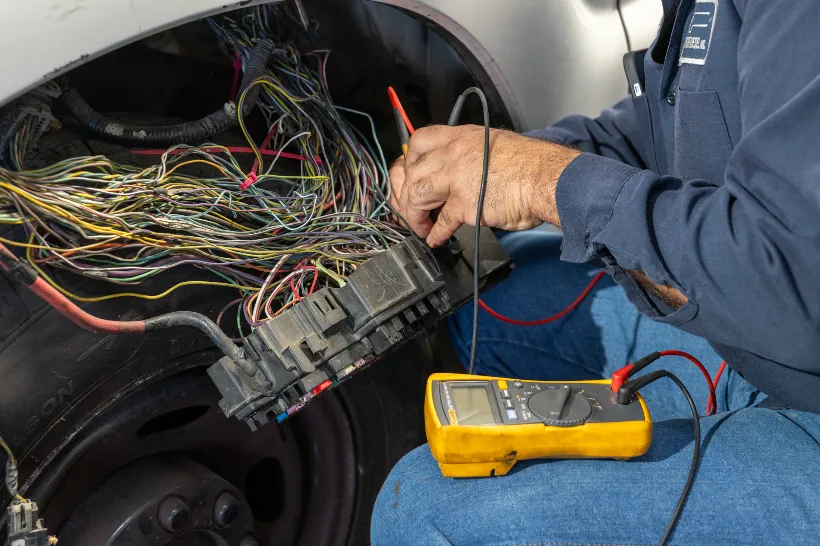
Fuel costs are one of the largest expenses for grocery delivery fleets. If you reduce these to as low as possible, then this can have a huge impact on the health of your budget. By adopting fuel-efficient strategies and investing in the right technology, you can mitigate against the uncertainty of fluctuating fuel prices.
Today, we’re going to take you through 8 easy actions you can take to make sure you’re getting the most bang for your buck at the pump!
Optimize Route Planning
Efficiency begins with planning. Advanced GPS systems and fleet management software can calculate the most fuel-efficient routes in real-time so your drivers avoid traffic congestion and unnecessary detours. If your software can do the following, then you’re on to a winner:
- Real-time traffic updates: To prevent idling in gridlock.
- Weather conditions: To avoid routes with adverse weather.
- Shortest distance with delivery stops: Minimizing mileage while covering all destinations.
We’ve written an article about the benefits of GPS tracking software where you can learn more about the topic!
Maintain Vehicle Health
The better condition your fleet is in, the more fuel-efficient they will be. Regular preventive maintenance
A well-maintained vehicle is a fuel-efficient one. Conducting regular preventive maintenance can drastically improve fuel economy. Key areas to focus on include:
- Tire Pressure: Under-inflated tires can reduce mileage by up to 3%. Use tire pressure monitoring systems (TPMS) to stay informed.
- Oil Changes: Clean oil reduces engine friction, improving efficiency.
- Air Filters: Replace dirty air filters to ensure proper airflow to the engine, enhancing combustion.
- Fuel Injectors: Ensure they are clean for optimal fuel spray and engine performance.
Implement Fuel-Saving Driving Practices
The way your drivers behave on the road can massively impact how much fuel they use. This is why routine training on correct driving techniques is essential. Things to highlight during these sessions include:
- Avoid hard braking and acceleration. These sudden movements waste fuel.
- Utilize cruise control on highways to maintain a steady speed.
- Limit idling: Turn off engines during long stops to save fuel.
Leverage Technology
Investing in modern telematics systems can provide insights into fuel consumption patterns and areas for improvement. These systems track:
- Driver behavior: Highlighting habits like speeding or excessive idling.
- Fuel usage trends: Identifying inefficiencies.
- Vehicle diagnostics: Sending alerts for maintenance needs.
Use Fuel Cards and Discount Programs
Fuel cards tailored for fleets often offer rebates and discounts at partnered fuel stations. It might not seem like much savings, but they soon add up and can be an absolute lifesaver for larger fleets.
Adopt Alternative Fuel Solutions
Exploring alternative fuels or hybrid vehicles can reduce dependency on traditional diesel. Consider:
- Compressed Natural Gas (CNG): A cleaner and often cheaper alternative.
- Hybrid-electric vehicles: Deliver greater mileage in urban settings.
- Biofuels: Renewable and eco-friendly, albeit with variable pricing.
Monitor Payload and Reduce Weight
Every extra pound requires additional energy to move—train loading staff to optimize cargo arrangements and reduce unnecessary weight. Lightweight vehicle components, like aluminum wheels or composite materials, can further enhance fuel efficiency.
Plan Delivery Schedules Strategically
Consolidating deliveries and scheduling them during non-peak hours can save both fuel and time. For instance, night-time deliveries may benefit from reduced traffic, allowing for smoother operations.
Recap
Reducing fuel costs in your grocery delivery fleet is not just about slashing expenses; it’s about building a smarter, more sustainable operation. By implementing route optimization, maintaining vehicles, encouraging efficient driving, and using the latest technology, you can enjoy better margins and a greener footprint.
More Articles
.webp)
.webp)
What Are the Main Causes of Brake Failure in Trucks (and How to Prevent Them)
What Are the Main Causes of Brake Failure in Trucks (and How to Prevent Them)
Brake failure is one of the top causes of truck accidents—and it’s often preventable. From air leaks to worn linings and poor adjustments, this guide covers the most common causes and how to avoid them with smart maintenance, inspections, and driver awareness.
.webp)
.webp)
5 Common Tire Maintenance Mistakes That Can Lead to Blowouts
5 Common Tire Maintenance Mistakes That Can Lead to Blowouts
Tire blowouts aren't random—they're preventable. From missed pressure checks to using the wrong tire type, small slip-ups lead to big problems. Learn the 5 most common tire maintenance mistakes that could leave your rig stranded across Rapid City or I-90.


How to Check for Parasitic Draws Draining Your Battery
How to Check for Parasitic Draws Draining Your Battery
A dead battery after downtime? You might be dealing with a parasitic draw—hidden power drains that silently kill your charge. Learn the signs, tools, and step-by-step fixes to track them down, prevent future issues, and keep your fleet running strong and start-ready.
